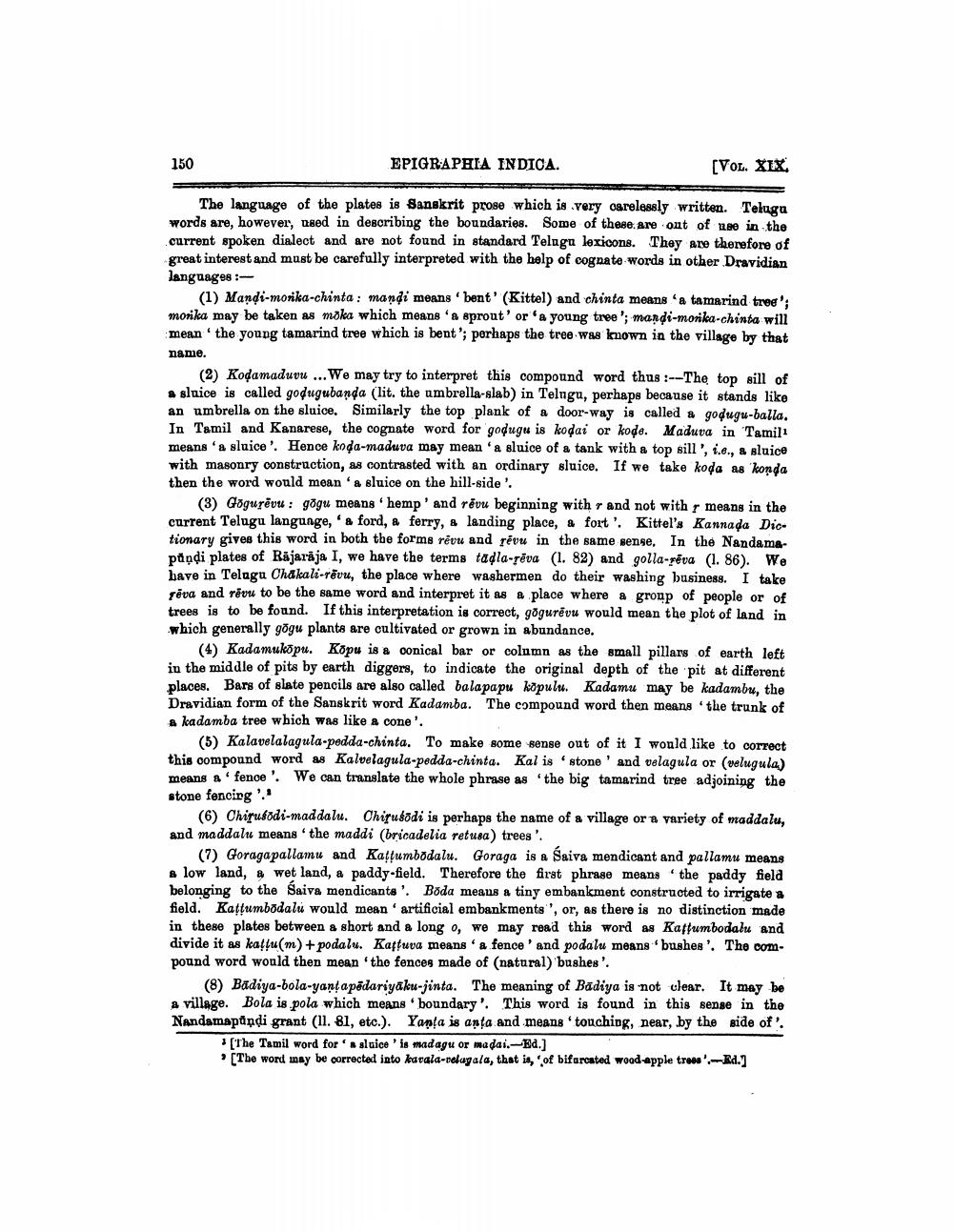________________
150
EPIGRAPHIA INDICA.
[VOL. XIX.
The language of the plates is Sanskrit prose which is very carelessly written. Teluga words are, however, used in describing the boundaries. Some of these are out of nee in the current spoken dialect and are not found in standard Telugu lexicons. They are therefore of great interest and must be carefully interpreted with the help of cognate words in other Dravidian languages :
(1) Mandi-morika-chinta : mandi means 'bent' (Kittel) and chinta means 'a tamarind tree': morika may be taken as moka which means 'a sprout' or a young tree'; mandi-morika-chinta will mean the young tamarind tree which is bent'; perhaps the tree was known in the village by that name.
(2) Kodamaduvu ... We may try to interpret this compound word thus :--The top sill of slnice is called godugubanda (lit. the umbrella-slab) in Telugu, perhaps because it stands like an umbrella on the sluice. Similarly the top plank of a door-way is called a godugu-balla. In Tamil and Kanarese, the cognate word for godugu is kodai or kode. Maduva in Tamil means a sluice'. Hence koda-maduva may mean'a sluice of a tank with a top sill', ...., & sluice with masonry construction, as contrasted with an ordinary sluice. If we take koda as 'konda then the word would mean'a sluice on the hill-side.
(3) Gogurēvui : gögu means 'hemp' and rēvu beginning with r and not with r means in the current Telugu langunge, ford, a ferry, & landing place, a fort'. Kittel's Kannada Dictionary gives this word in both the forms rēru and rêvu in the same sense. In the Nandamepåndi plates of Rajaraja I, we have the terms tadla-tēva (1. 82) and golla-rēva (1. 86). We have in Telugu Chakali-rēvu, the place where washermen do their washing business. I take rēva and rēvu to be the same word and interpret it as a place where a group of people or of trees is to be found. If this interpretation is correct, gögurēvu would mean the plot of land in which generally gogu plants are cultivated or grown in abundance.
(4) Kadamukopu. Kopu is a conical bar or colnmn as the small pillars of earth left in the middle of pits by earth diggers, to indicate the original depth of the pit at different places. Bars of slate pencils are also called balapapu kopula. Kadamu may be kadambu, the Dravidian form of the Sanskrit word Kadamba. The compound word then means the trunk of a kadamba tree which was like a cone'.
(5) Kalavelalagula-pedda-chinta. To make some sense out of it I would like to correct this compound word as Kalvelagula-podda-chinta. Kal is stone' and velagula or (velugula.) means a fence'. We can translate the whole phrase as the big tamarind tree adjoining the stone fencing!!
(6) Chirufodi-maddalu. Chirusodi is perhaps the name of a village or a variety of maddalu, and maddal means the maddi (bricadelia retusa) trees'.
(1) Goragapallamu and Kaffumbodalu. Goraga is a Saiva mendicant and pallamu means a low land, & wet land, a paddy-field. Therefore the first phrase means the paddy fiela belonging to the Saiva mendicants'. Boda means a tiny embankment constructed to irrigate a field. Kattumbodalu would mean artificial embankments', or, as there is no distinction made in these plates between a short and a long 0, we may read this word as Kaffumbodalu and divide it as kaffu(m) + podalu. Kaffuua means a fence and podalu means 'bushes'. The compound word would then mean the fences made of natural) bushes'.
(8) Badiya-bola-yant a pădariyaku-jinta. The meaning of Badiya is not clear. It may be a village. Bola is pola which means boundary'. This word is found in this sense in the Nandamapandi grant (11. 81, etc.). Yanga is anta and means touching, near, by the side of'.
[The Tamil word for ' sluice is madagu or madai -Ed.) [The word may be corrected into kavala-nelayala, that is, of bifarcated wood apple treas',-Ed.]




